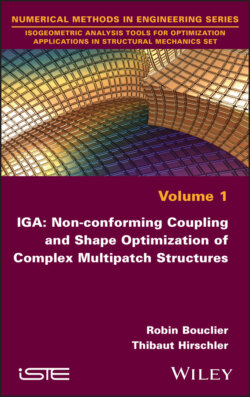Читать книгу IGA - Robin Bouclier - Страница 15
1.2.2.1. B-spline curves
ОглавлениеThe B-spline technology enables us to describe geometric entities in terms of smooth piecewise polynomials (Gordon and Riesenfeld 1974; Piegl and Tiller 1997). First, taking the univariate case, it expresses curves in the parametric form as:
[1.9]
where Pi is the control point associated with the univariate pth-degree B-spline basis function . Note that Pi can live in a 1D (Pi = xi), 2D (Pi = (xi, yi)) or 3D (Pi = (xi, yi, zi)) physical space. As stated above, the n1 B-spline basis functions are piecewise polynomial functions. Their expression is obtained by specifying a knot-vector Ξ1 and a polynomial degree p. Thus, three inputs are required to define B-spline curves: the degree, the knot-vector and the control points. The degree p obviously takes an integer value. The knot-vector is a non-decreasing sequence of n1 + p + 1 real numbers, referred to as knots, that divide the parameter space into knot-span elements. The interval constitutes the spline patch. Unlike standard FE where each element has its own parameterization, the parameter space of B-spline functions is localized onto the patch that may be thought of as a macro-element. Preliminary illustrations of B-spline entities, along with their B-spline functions, are provided in Figures 1.3 and 1.4. Usually in IGA, the first p + 1 knots are identical and equal to the parameter lower bound, and the last p + 1 knots are identical and equal to the parameter upper bound. In this case, the basis is interpolating at the boundary knots of the patch, which facilitates the application of boundary conditions when performing numerical simulations. This treatment is performed in this work. Considering 1 = [a1, b1], this leads to so-called open knot-vectors that are of the form:
[1.10]
where the interior knots verify the conditions
Figure 1.3. Quadratic B-spline curve with
Figure 1.4. Quadratic B-spline curve with a non-uniform knot-vector. The initial knot used in Figure 1.3 has been changed by (the dotted lines repeat the uniform knot-vector case)
Returning to the examples, Figure 1.3 depicts a quadratic (i.e. p = 2) B-spline curve, where the knot-vector was chosen as:
[1.11]
This knot-vector is characterized as uniform since all interior knots are equally spaced. The influence of the knot-vector is shown in Figure 1.4, where we only changed one knot of the initial knot-vector such that:
[1.12]
This new knot-vector is characterized as non-uniform because the interior knots are not equally spaced.
